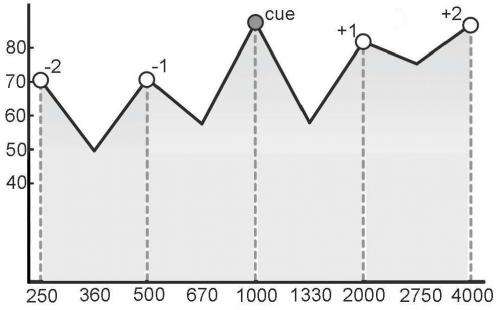Illustration 1. Method used in experiment. The experimental subjects heard noise for an hour, with a tone of 1000 Hz (the cue) being sounded every few seconds. Then they heard a second tone somewhere between 250 Hz and 4000 Hz during one of two intervals. They indicated on a computer when (in which of the two intervals) they heard the test tone.
The processing of sound in the brain is more advanced than previously thought. When we hear a tone, our brain temporarily strengthens that tone but also any tones separated from it by one or more octaves. A research team from Utrecht and Nijmegen published an article on the subject in the journal PNAS on 2 September.
We hear with our brain. The cochlea picks up sound vibrations but the signals produced as a result are processed by the brain, using known patterns. If, for example, you briefly hear a weak tone, your hearing focuses on that tone and suppresses any frequencies around it. This makes it easier to notice any relevant sounds in your surroundings. The present research has shown that this 'auditory attention filter' is much more complex than believed until now: frequencies that have an octave relationship with the target tone are also heard better.
John van Opstal, professor of Biophysics at Radboud University: 'This test proves that the brain prepares for a more extensive pattern of tones, even if the person just hears a single test tone or if he has a tone in mind. These extra tones in the pattern were not sounded during the experiment, but the brain complements the information received from the cochlea. This is scientifically interesting. Audiology, for example, at present places great emphasis on the cochlea.'
Octave relationship
The subjects undergoing the experiment did not have an easy time. For an hour they listened to unstructured noise containing very soft tones that they had to detect. Every few seconds they were presented with a tone of 1000 Hz, the cue. Then during one of two time intervals, a very quiet, short second tone was sounded. The subject had to indicate in which of the two intervals they had heard the second tone. It became apparent that tones having an octave relationship with the cue were all heard better, and those around the cue were heard less well. An octave is a well-known term in music, indicating the distance between two tones, the frequencies of which have a 2-to-1 relationship.
Illustration 2. Results of experiment. The frequencies of the tones sounded are shown in Hz on the X-axis. The Y-axis has the percentage of correct responses given by the subjects (50% is pure guesswork). Whenever the second tone was the same as the cue – 1000 Hz – detection was better. The subjects detected any tones around that cue tone less well; they more often indicated the wrong time interval. Peaks also appeared at 250 Hz, 500 Hz, 2000 Hz and 4000 Hz; that was surprising.
Voice
Van Opstal: 'We wanted to gather data on the auditory attention filter around the target tone. When we made the range larger than other researchers had done previously, more peaks suddenly appeared. This was a complete surprise to us. One possible explanation could be that the hearing system has evolved in order to hear sounds made by members of an animal's own species (voices in the case of humans) in noisy surroundings. Vocalisations always consist of harmonic complexes of several simultaneous tones having an octave relationship with each other.'
Hearing aid
The researchers, who work at Utrecht University, the UMC Utrecht Brain Center and Radboud University Nijmegen, can easily think up applications for this fundamental research. If, for example, someone no longer hears high tones because of damage to the cochlear hair cells, the hearing aid can be adjusted in such a way that it converts those tones so they sound one or more octaves lower. Since the brain itself 'fills in' tones with an octave relationship, that person's perception should then become more normal. It is also important for commercial sound producers to know how tones are perceived. That is why Philips Research is involved in this research in their department 'Brain, Body and Behavior'.
More information: Octave effect in auditory attention, www.pnas.org/cgi/doi/10.1073/pnas.1213756110
Journal information: Proceedings of the National Academy of Sciences
Provided by Radboud University Nijmegen





















